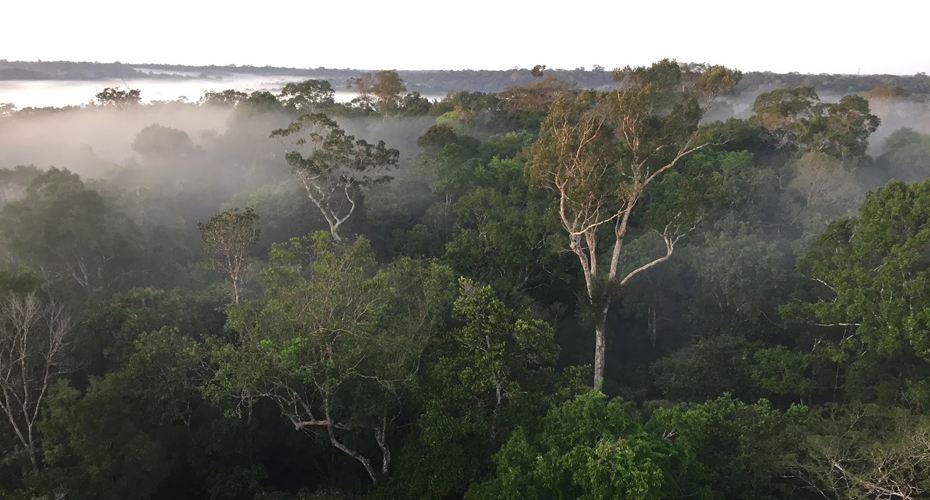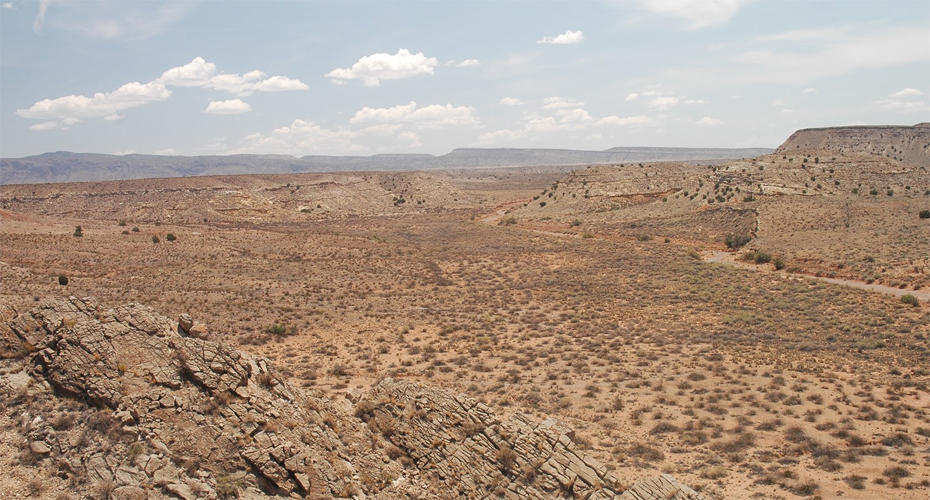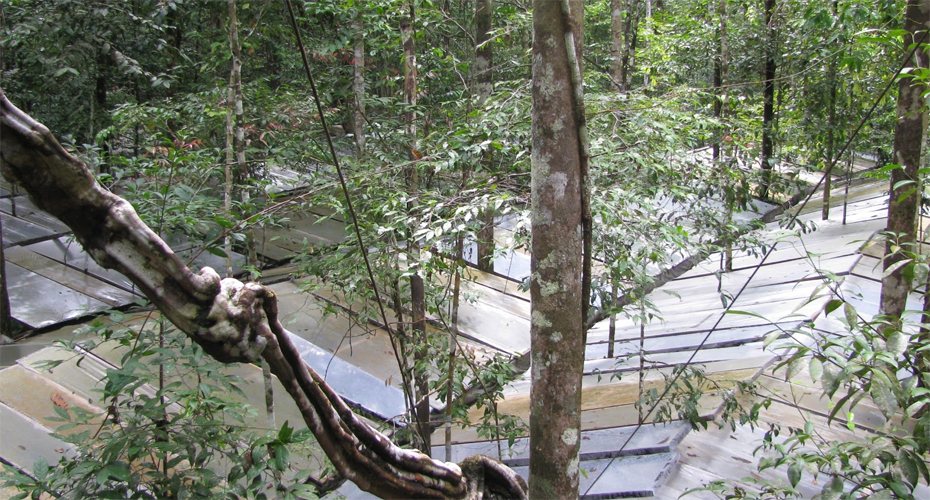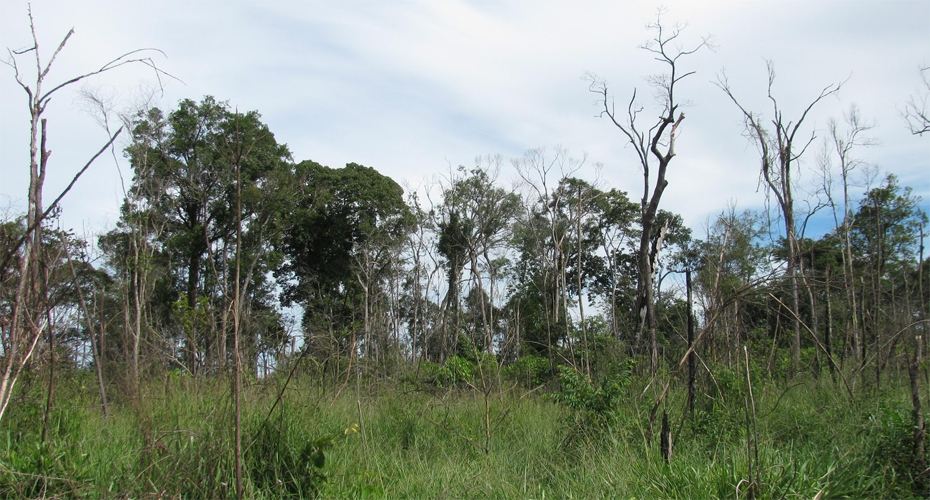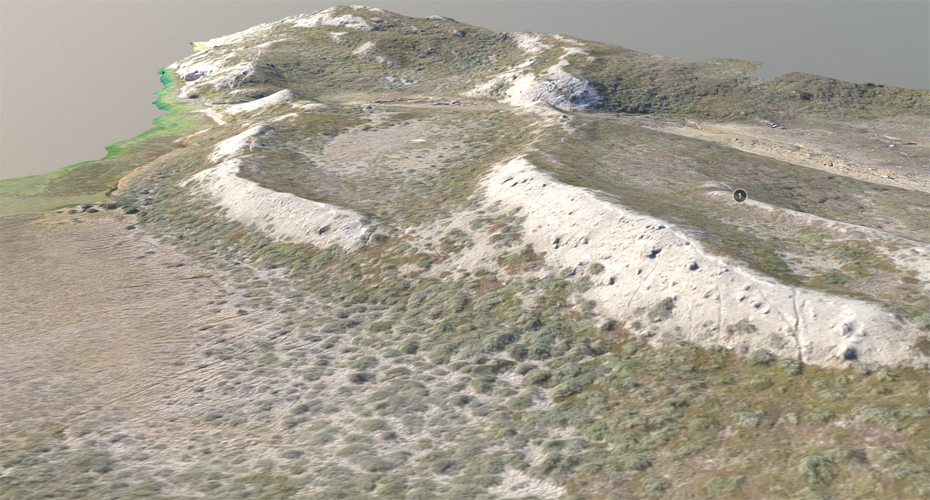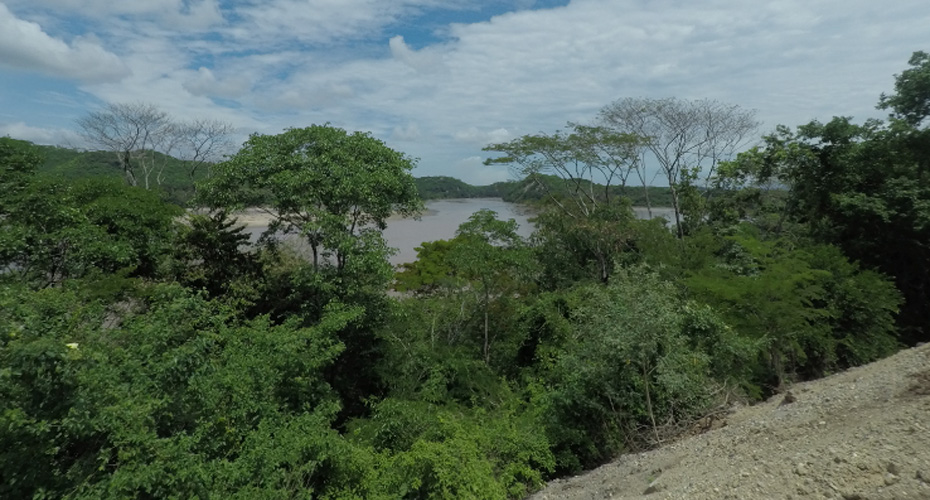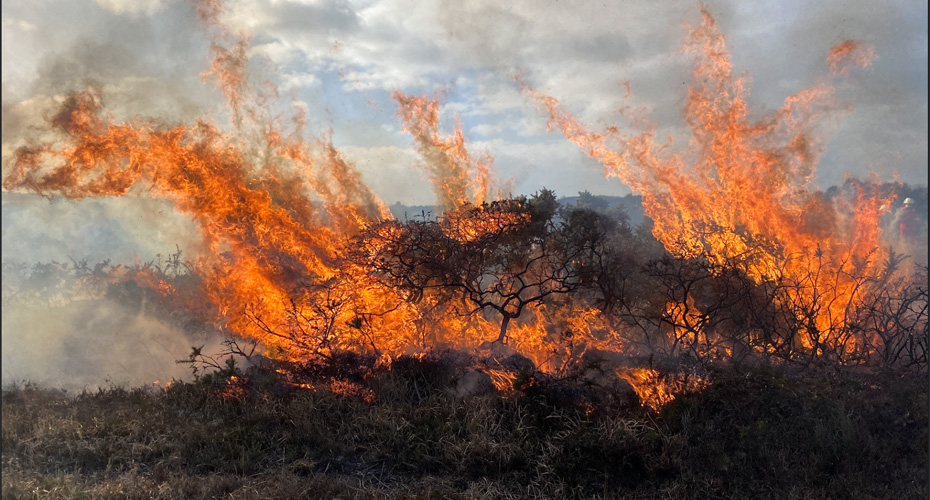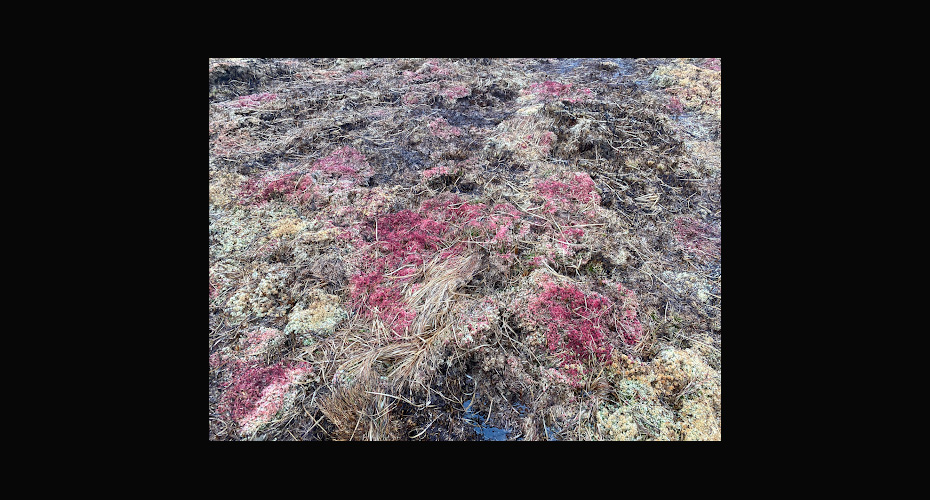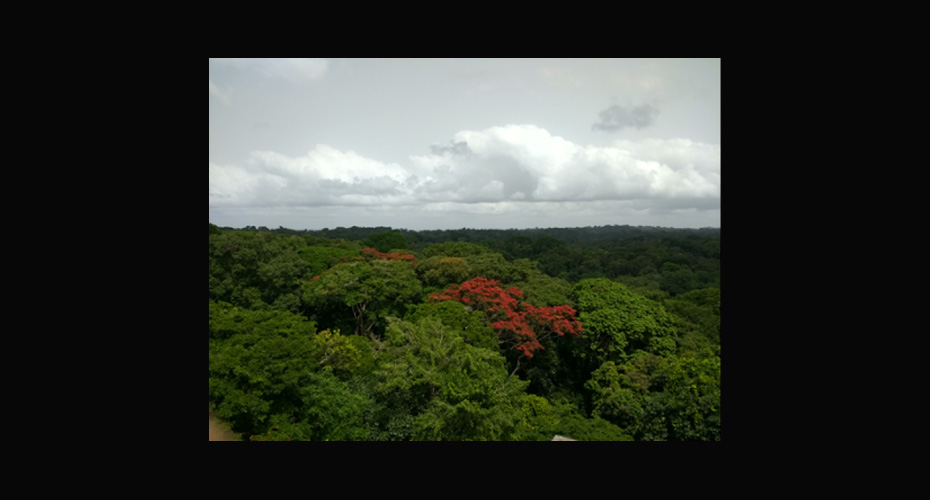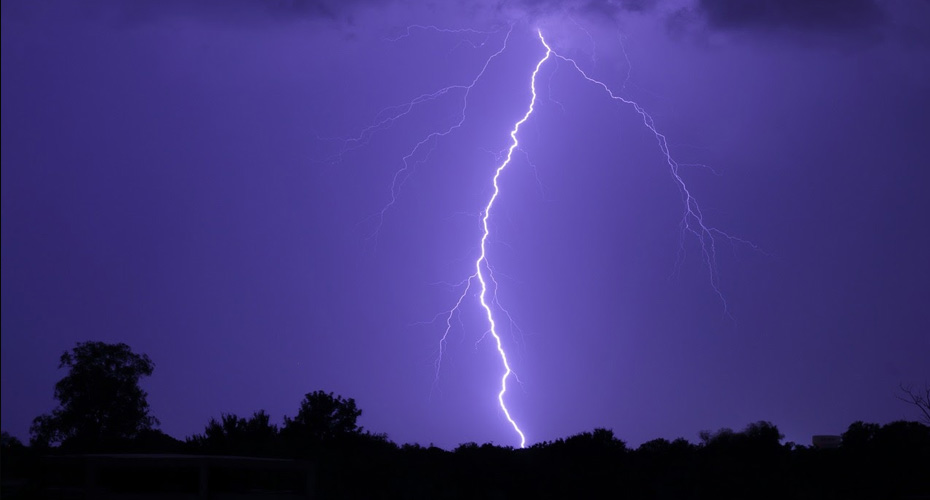Vegetation
Projects
Supervisors: Dr Lina Mercado (email: L.Mercado@exeter.ac.uk) and Prof Stephen Sitch (email: S.A.sitch@exeter.ac.uk)
Project description
The scientific issue
A major uncertainty in climate change prediction is the response of vegetation to extreme temperatures (Booth et al 2012; Friedlingstein et al 2014). Leaves are able to thermoregulate (Michaeltz et al 2016). For example, via evapotranspiration plants are able to cool their leaves (Urban et al 2017). Leaf and not air temperature determines key biological processes such as photosynthesis, respiration, transpiration and emissions of volatile organic compounds. Despite its relevance for carbon and water cycle processes, leaf temperature has been neglected and thus rarely evaluated in global vegetation and Earth system models, with some models assuming air temperature is the same as leaf temperature. Thus there is a need to i) understand and quantify leaf and canopy temperatures and their implications for plant functioning and ii) evaluate their representation in Earth system models.
The research
We propose to use existing high temporal resolution records of proxy temperature variables to infer canopy temperature across representative ecosystems around the world to derive understanding of most predominant patterns of canopy temperature during main growing season conditions and use these values to evaluate the validity of leaf temperature predictions with energy balance formulations that are currently used inside global and Earth system models. Inferred canopy temperatures will also be used to evaluate their relationship against canopy conductance, latent and sensible heat and gross primary productivity. The project will deliver key understanding of canopy level temperatures and will provide key information to improve canopy temperature modelling to the vegetation and Earth system modelling communities.
Candidate needs numerical and coding skills.
References
Booth BB, Jones CD, Collins M, Totterdell IJ, Cox PM, Sitch S, Huntingford C, Betts RA, Harris GR, Lloyd J. High sensitivity of future global warming to land carbon cycle processes. Environmental Research Letters. 2012. 7(2):024002.
Friedlingstein P, Meinshausen M, Arora VK, Jones CD, Anav A, Liddicoat SK, Knutti R. Uncertainties in CMIP5 climate projections due to carbon cycle feedbacks. Journal of Climate. 2014 27(2):511-26.
Michaletz ST, Weiser MD, McDowell NG, Zhou J, Kaspari M, Helliker BR, Enquist BJ. The energetic and carbon economic origins of leaf thermoregulation. Nature plants. 2016. 2(9):16129.
Urban J, Ingwers MW, McGuire MA, Teskey RO. Increase in leaf temperature opens stomata and decouples net photosynthesis from stomatal conductance in Pinus taeda and Populus deltoides x nigra. Journal of experimental botany. 2017.68(7):1757-67.
Supervisors: Prof Richard Brazier (email: r.e.brazier@exeter.ac.uk) Prof Stephen Sitch (email: s.a.sitch@exeter.ac.uk), Dr Karen Anderson (email: Karen.Anderson@exeter.ac.uk), Dr Tim Hill (email: T.C.Hill@exeter.ac.uk) and Dr Andrew Cunliffe (ac365@exeter.ac.uk).
Project Description
The scientific issue
Drylands cover ca. 40% of the global land area and are predicted to cover 50% by 2100, storing 8 - 25% of terrestrial organic Carbon (C). Dryland climates are highly variable (Wainwright et al., 2005; Petrie et al., 2014), particularly in terms of rainfall and, as water-limited ecosystems, C uptake and release is very sensitive to this variability. Recent large-scale modelling studies suggest that temporal fluctuations in dryland vegetation biomass may control both inter-annual variability (IAV) and long term trends in the land C sink (Poulter et al., 2014; Ahlström et al., 2015). If such predictions are correct, drylands may become increasingly important drivers of global C cycles and tropical rainforests may become less relevant in the future (Ahlström et al., 2015). Yet such predictions are empirically unfounded, indeed a strong divergence in opinion exists on the potential for C storage in drylands. Thus, significant uncertainty surrounds understanding of dryland C cycles.
The research
To tackle this uncertainty we are interested in supervising research projects to work within (or across) the three major drylands that comprise the US south west landscape; the Mojave, Sonoran and Chihuahuan deserts. We have expertise in our academic team that the appropriate combination of us could supervise projects using a wide range of techniques and approaches, including, but not limited to:
- Remote sensing within, for example, the Google Earth Engine (GEE) platform – where there are exciting opportunities to learn cutting edge skills on the world’s most powerful analytical geospatial environment. The right candidate would develop strong skillsets in this area, providing a strong foundation to further work in research and/or industry, where use of remotes sensing and Geographical Information Science (GIS) is growing rapidly.
- Measurement and monitoring of gaseous carbon fluxes from land to atmosphere, across scales from plant to ecosystem scale. We have developed approaches to quantify net carbon loss or gain using novel low cost systems, and how this varies across ecosystems (Hill et al., 2017). We can therefore supervise cutting-edge research into the way the carbon cycle behaves in deserts, during, for example, wet versus dry seasons, or in communities dominated by different plant functional types.
- Using lightweight drone systems to survey vegetation structure and inventory aboveground biomass stocks. We have pioneered these approaches (Cunliffe et al. 2016) and would welcome applications from candidates to extend understanding of the aboveground stocks of carbon and how these differ between plant types and change in response to rainfall variability (for example). Candidates would thus gain high-level training in drone operation, deployment and data analysis, a skillset which is highly transferable within the growing sector of drone-based measurement and research.
The MbyRes project will be able to draw upon significant logistical and financial support from our team, but also from our project partners in the USA. We expect a successful project in this area would result in a peer-reviewed paper, led by the student. Furthermore, we would anticipate that a successful MRes project could provide a platform to continue to undertake a PhD, in the same subject area, working alongside our team in the recently NERC-funded DRIVING-C (Dryland Regions control Interannual Variability In Global Carbon flux) project.
References
Ahlström et al., 2015. The dominant role of semi-arid ecosystems in the trend and variability of the land CO2 sink. Science 348, 895–899.
Cunliffe et al., 2016. Ultra-fine grain landscape-scale quantification of dryland vegetation structure with drone-acquired structure-from-motion photogrammetry. Remote Sensing of Environment 183, 129–143.
Hill et al., 2017. The case for increasing the statistical power of eddy covariance ecosystem studies: why, where and how? Glob Change Biol 23, 2154–2165.
Poulter et al., 2014. Contribution of semi-arid ecosystems to interannual variability of the global carbon cycle. Nature 509, 600–603.
Petrie et al., 2015. Grassland to shrubland state transitions enhance carbon sequestration in the northern Chihuahuan Desert. Glob Change Biol 21, 1226–1235.
Wainwright., 2005. Climate and climatological variations in the Jornada Experimental Range and neighbouring areas of the US Southwest. Advances in Environmental Monitoring and Modelling 2.
Supervisors: Dr. Lucy Rowland (email: l.rowland@exeter.ac.uk), Prof. Stephen Sitch (email: s.sitchexeter.ac.uk), Prof. Maurizio Mencuccini (email: m.mencuccini@creaf.uab.cat) and Prof. Patrick Meir (email: patrick.meir@anu.edu.au).
Project Description
The scientific issue
Tropical rainforests are one of the world’s most important carbon stores and centres of biodiversity. They are also one of the key Earth system elements that could act as a tipping point in relation to controlling global climate change. However, these rainforest ecosystems are predicted to be threatened by future changes in climate, particularly the increasing threat from drought. Understanding and predicting how tropical forests will respond to drought is crucial to predicting global responses to rising CO2 levels, alongside planning to conserve tropical rainforests into the future.
One of the fundamental responses of tropical trees to drought lies in regulating their water transport from the soil to the leaves. Patterns of water transport in trees control the likelihood of their risk of drought-induced mortality as well as regulating the amount of water which is recycled back into the atmosphere, a fundamental process affecting climate. However, water transport or sapflux data, are rarely collected in tropical rainforests, despite the value of this information for validating global climate change predictions from models.
The research
This research will be using data from the world’s longest running tropical rainforest drought experiment or through-fall exclusion experiment (TFE) located in the north eastern part of the Brazilian Amazon. The TFE consists of 1-hectare area of old-growth rainforest with a plastic panelling structure inserted at 2 m above the ground to deflect rainfall away from the soil. This structure has been used to exclude 50% of the incoming rainfall from the soil since 2002 creating a 17-year artificial drought. It has been continuously studied alongside a adjacent corresponding control forest. Sapflux data have been collected from 2014 to present on a selection of 21 – 30 trees, a period which crucially included the 2015/2016 El Niño event. The focus of this project will be to undertake a detailed analysis of these data on an individual tree basis to understand how tree size, location and species may be affecting the responses of tropical tree sapflux to the TFE treatment, the 2015/16 El Niño, as well as general responses to natural climate variability.
The student will have the opportunity to join a productive international team and to make an extended visit to Prof. Mencuccini at CREAF in Barcelona to integrate with his research team, which includes the creators of the world’s first global sapflux database.
The candidate needs to have a good understanding of ecological processes and experience processing data in a statistical software package, preferably R.
References
- Da Costa et al., 2017. Stand dynamics modulate water cycling and mortality risk in droughted tropical forest. Global Change Biology. Doi: 10.1111/gcb.13851
- Rowland et al., 2015. Death from drought in tropical forests is triggered by hydraulics not carbon starvation. Nature. 528, 119–122
- Poyatos et al., 2016. SAPFLUXNET: towards a global database of sap flow measurements. Tree Physiology, 36, 12, 1449–1455.
- Fisher et al., 2007. The response of an Eastern Amazonian rain forest to drought stress: Results and modelling analyses from a throughfall exclusion experiment. Global Change Biology, 13, 2361–2378.
- Meir et al., 2015. Threshold responses to soil moisture deficit by trees and soil in tropical rain forests: Insights from field experiments. BioScience, 65, 882–892.
Supervisors: Dr Ted Feldpausch (email: t.r.feldpausch@exeter.ac.uk), Dr Luiz Aragão, Dr Claire Belcher
Project Description
The scientific issue
Results from long-term Amazon Basin-wide permanent plot data indicate that mature tropical forests are gaining carbon, resulting in a substantial carbon sink (~0.5 PgC yr-1) that has slowed the rise of atmospheric [CO2] due to fossil fuel burning (Phillips et al. 2009). However, the rate of C uptake is declining, resulting in a weakening of the Amazon C sink (Brienen et al. 2015). Understanding the drivers of these changes are vital to predicting the longevity and magnitude of the C sink. Amazon forests have an uncertain history over the past 1000 years, and it is unclear how historical disturbance, including past fires, affects the carbon balance of Amazonia today. For example, fire preferentially kills smaller stems, resulting in long-term changes affecting forests for decades. Fire also modifies soils through the production of charcoal, a recalcitrant form of soil carbon. Improving understanding of how historical fire interacts with forests and soils will help to understand drivers of the Amazon forest carbon sink and improve planning for conservation and Reducing Emissions from Deforestation and forest Degradation (REDD+). Despite the potential significance, very little is known about the effect of the past fires on Amazonian ecological processes.
The research
This research will address questions related to drivers of variation in soil C or in vegetation structure, dynamics, and composition using datasets collected from old-growth permanent forest plots across Amazonia. The field data consist of forest inventory data (composition, growth, recruitment, mortality) and soil chemical data (e.g., pyrogenic carbon, physicochemical analysis). A suite of analytical tools could be applied such as Google Earth Engine, machine learning, geospatial analysis and remote sensing to evaluate the interaction between past fire, climate, and forests. The student needs to be numerically competent and have a strong understanding of ecological concepts and using statistical programs such as R. The project provides the opportunity to work in a world-class research team on a genuinely novel research question and also ample opportunity to develop your own research interests. You will join an interdisciplinary group of tropical ecologists, fire and soil scientists, botanists, and remote sensing specialists who have been funded to undertake the first Amazon Basin-scale study of historical fire effects on old-growth Amazonian forests.
References
Feldpausch, T.R. et al., Amazon forest response to repeated droughts. Global Biogeochem. Cycles 30, 964-982 (2016).
Koele, N. et al., Amazon Basin forest pyrogenic carbon stocks: First estimate of deep storage. Geoderma 306, 237-243 (2017).
Massi, K. G. et al., Does soil pyrogenic carbon determine plant functional traits in Amazon Basin forests? Plant Ecol. 218, 1047-1062 (2017).
Phillips, O. et al., Drought sensitivity of the Amazon rainforest. Science 323, 1344-1347 (2009).
Supervisor: Dr Ted Feldpausch (email: t.r.feldpausch@exeter.ac.uk); Dr Lina Mercado; Prof Stephen Sitch, Dr Luiz Aragão
Project Description
The scientific issue
Intact tropical forests are an important reservoir of biodiversity and carbon (C) and play a critical role in climate regulation. Tropical forest degradation, i.e. a direct human-induced reduction in the overall capacity of a forest to provide benefits (e.g. C, biodiversity), is pervasive and a growing threat to the global land C sink (IPCC, 2007; Pan, 2011). Recent estimates suggest that global tropical forests are a net C source, and that degradation accounts for ~70% of overall C losses (Baccini et al., 2017); however, estimates are highly uncertain. Large-scale forest degradation may be particularly severe in Amazonia, the largest global forest degradation frontier, while also having suffered major drought and temperature anomalies in 2005, 2010, and 2015 (Feldpausch et al. 2016; Jiménez-Muñoz et al. 2016). There is a major debate, however, on the scale and degree of forest degradation and its drivers. Quantifying the cryptic changes resulting from of forest degradation and the forest response to climate requires a large-scale integrated approach rooted in long-term measurements. Furthermore, climate change is anticipated to have profound impacts on the stability of carbon and water cycles, biodiversity and human populations in tropical forest nations. Projected changes in climate such as the rise in temperature and augmented frequency of droughts in tropical regions are likely to act as a two-way problem: 1) Climate change is likely to increase the extent of degraded forests and 2) alter the responses and recovery patterns of these degraded forest. Collapse in functional processes of the periphery seasonally dry forests of Amazonia could signal a switch to an alternative state and affect the climate of ‘core’ wetter Amazonian forests, having catastrophic effects on global C and diversity. Improving understanding of how logging and/or fire interact with forests and changing climate (e.g., precipitation deficits and thermal anomalies) will help to predict the long-term fate of the Amazon forest carbon sink and improve planning for conservation and Reducing Emissions from Deforestation and forest Degradation (REDD+).
The research
The project addresses these uncertainties by quantifying how human-induced disturbances affect the uptake and release of carbon from Amazon forests along the so called ‘Arc of Deforestation’, the largest degradation frontier in the world. The project could employ a variety of interdisciplinary approaches using tools from ecology, fire science, and remote sensing. The field data consist of LIDAR data with embedded permanent forest plots with forest inventory data representing coarse woody debris, tree size, and species ID. Additional plant functional trait data, remote sensing data and analytical tools could be applied such as Google Earth Engine, machine learning, and geospatial analysis to evaluate the interaction between fire, climate, and forests. The student needs to be numerically competent and have a strong understanding of ecological concepts and using statistical programs such as R. This project provides the opportunity to work in a world-class research team on a novel research question and also ample opportunity to develop your own research interests. You will join an interdisciplinary group of tropical ecologists, fire and soil scientists, vegetation modellers, and remote sensing specialist. The results will have significant impacts in predicting the response of tropical forests to anthropogenic disturbance and the role of changing climate. This has important implications for understanding long-term fire effects, estimating rates of carbon update (or further loss) in degraded forests, informing conservation plans, improving vegetation models, and affecting policy such as REDD+.
References
Baccini et al., Tropical forests are a net carbon source based on aboveground measurements of gain and loss. Science, (2017).
Feldpausch, T.R. et al., Amazon forest response to repeated droughts. Global Biogeochem. Cycles 30, 964-982 (2016).
IPCC, "Climate change 2007- The physical science basis," Intergovernmental Panel on Climate Change IPCC working group I fourth assessment report (Cambridge, UK, 2007).
Jiménez-Muñoz et al., Record-breaking warming and extreme drought in the Amazon rainforest during the course of El Niño 2015–2016. Scientific reports 6, (2016).
Pan et al., A large and persistent carbon sink in the world's forests. Science 333, 988-993 (2011).
Determining drivers of variation in vegetation development in Greenland using UAV and satellite data
Supervisors: Dr Steven Palmer (email: s.j.palmer@exeter.ac.uk) and Dr Ted Feldpausch (email: T.R.Feldpausch@exeter.ac.uk)
Project Description
The scientific issue
Climate warming has led to changes in the composition, density and distribution of Arctic vegetation in recent decades. The nature of Arctic vegetation change under a warming climate will influence climate feedbacks; yet, Earth system modelling studies have so far taken an overly-simplistic view of future changes, for example assuming an arbitrary increase in the extent of shrublands. There is, therefore, a need for better understanding of likely future changes in Arctic vegetation distribution, based on observations of vegetation change over time. In the ~40 000 km2 land-terminating sector of SW Greenland, Holocene ice retreat has resulted in areas exposed to differing climate histories and growing season lengths, which can be used to test hypotheses relating climate to vegetation structure and dynamics. In addition, wildfires across the Arctic have become increasingly common, and in August 2017, wildfires of unprecedented extent occurred in parts of SW Greenland. This project seeks to perform an assessment of the impacts of these extensive wildfires and interactions with the colonising vegetation.
The research
This project seeks to combine UAV-derived point cloud data acquired in 2017 with Landsat & MODIS satellite observations, and long-term climate data, to investigate the relationships between NDVI and vegetation characteristics, and changing climate in Greenland. This will then be used to make estimates of the distribution of different vegetation types as a function of distance from the current ice sheet margin, and therefore time since deglaciation. These results will be used to infer variations in growing season histories, and to investigate the impacts of these variations on vegetation structure. The student needs to have strong GIS skills and have a thorough understanding of ecological concepts and using statistical programs for data analysis (e.g. R). This project provides the opportunity to work in a world-class research team and develop skills that cut across remote sensing, glaciology, climate science, and plant ecology. The results of this study will have wider relevance throughout the Arctic, including for making improved predictions of impacts on the carbon cycle, conservation, and policy.
References
Elmendorf, S. C., Henry, G. H., Hollister, R. D., Björk, R. G., Boulanger-Lapointe, N., Cooper, E. J., ... & Gill, M. (2012). Plot-scale evidence of tundra vegetation change and links to recent summer warming. Nature Climate Change, 2(6), 453-457.
Pearson, R. G., Phillips, S. J., Loranty, M. M., Beck, P. S., Damoulas, T., Knight, S. J., & Goetz, S. J. (2013). Shifts in Arctic vegetation and associated feedbacks under climate change. Nature Climate Change, 3(7), 673-677.
Mack, M. C., Bret-Harte, M. S., Hollingsworth, T. N., Jandt, R. R., Schuur, E. A., Shaver, G. R., & Verbyla, D. L. (2011). Carbon loss from an unprecedented Arctic tundra wildfire. Nature, 475(7357), 489-492.
Supervisor: Stephen Sitch (email: s.a.sitch@exeter.ac.uk), Lina Mercado (email: l.mercado@exeter.ac.uk)
Project Description
The scientific issue
Climate is predicted to warm fastest in high-latitudes due to biogeophysical snow-albedo feedbacks. Boreal forests and tundra vegetation will respond to climate changes, e.g. with a northward migration of the tree line, and potentially further enhance warming as a dark tree canopy replaces the low stature winter snow-covered tundra. In addition, high-latitude ecosystems store vast stocks of carbon, potentially vulnerable to warming. Whether high-latitude ecosystems are a future carbon source or sink with climate change depends on the balance between enhanced vegetation growth (C sink) versus enhanced decomposition and/or forest dieback (C source). Given the importance of high-latitude ecosystems in the climate system, it’s disconcerting that the response of boreal forests to climate change is so uncertain and divergent across modelling studies (Sitch et al., 2008). An accurate representation of boreal forests and arctic tree line dynamics are crucial for underpinning regional and global climate change projections (Hopcroft et al., 2015). There is also debate in the satellite remote sensing community on recent trends in high latitude ecosystems, with some studies suggesting a boreal forest browning (warming negatively affecting existing forests) and concurrent tundra greening (shrub/forest encroachment). High latitude vegetation coverage has a big impact on the ITCZ location generally, and impacts the position of the Indian Monsoon system. Many of the biases found in the Hadley Earth System Model may be due to the lack of simulated forest coverage in the eastern Siberian region.
The research
Only recently have global models started to consider key processes relevant to high-latitude ecosystems, e.g. permafrost soils, insulation due to moss layer, peatlands and fire disturbance. There is a major gap in the modelling of high-latitude vegetation and its response to climate change, and related climate teleconnections. In this project you will investigate boreal forest dynamics, analysis results from a suite of vegetation models from the TRENDY intercomparison, with the aim to improve the parameterisation of boreal forests in a land surface model, JULES, the land component of the UK Earth System Model.
References
Hopcroft, P.O., P.J. Valdes (2015) Last glacial maximum constraints on the Earth System model HadGEM2-ES, Climate Dynamics, 45(5), pp 1657-1672.
Sitch, S., et al., (2008) Evaluation of the terrestrial carbon cycle, future plant geography, and climate-carbon cycle feedbacks using 5 Dynamic Global Vegetation Models (DGVMs). Global Change Biology,14 1-25, doi:10.1111/j.1365-2486.2008.01626.x
Supervisor: Toby Pennington (email: t.pennington@exeter.ac.uk); Peter Moonlight, Tiina Sarkinen (Royal Botanic Garden Edinburgh)
Project Description
The scientific issue
The evidence for the presence of plant species in tropical countries comes from dried specimens preserved in museum collections (herbaria). Based upon the numbers of these herbarium specimens that have been collected, many plant species in the tropics are very rare – represented by less than five specimens in the world’s collections. Many of the collections of these species were made decades ago, even as far back as the 19th century. This raises the possibility that the habitat in which they were collected no longer exists because of extensive land use changes in the tropics. If all the areas where the individuals of a species no longer have land cover of natural habitat then these species should be highlighted as priorities for re-discovery by biodiversity exploration. Sadly, it seems likely that many may already be locally or even globally extinct.
This project will examine the distributions of some of these rare species in the “caatinga” dry forests of northeastern Brazil and examine how they may have been impacted by landuse changes. Tropical dry forests once covered much of Latin America where rainfall is too seasonal to support rainforests. However, because of their fertile soils and high human populations, they have suffered much higher deforestation than many rain forests, especially Amazonia. In many countries, only 10% of tropical dry forests remain, making them one of the world’s most endangered tropical forests. This is the case for the caatinga forests of northeastern Brazil, which once covered 800,000 square kilometres but have been reduced to fragments of this original extent.
The research
A recent study of herbarium specimens from all major collections in Brazil for plants found in the caatinga region shows that of 16351 species recorded, 7053 are represented by fewer than five herbarium collections. In this project, you will georeference these specimens based upon the collection location written on the specimen labels (meaning that some ability in Portuguese or Spanish may be an advantage). This will enable you to gain an estimate of the distribution of these species. You will then examine land cover maps of Brazil to determine whether the natural dry forest habitat of the species remains in the areas where they were collected, or whether it has been replaced by urban expansion, cropland or other land uses.
The result of this project will a list of species for which no natural habitat exists where they have been collected, and which should be considered a priority for future exploration (for example, by examining their environmental preferences to make predictions about where they might be found). The project will also allow an estimate of how many species in the dry forests of northeastern Brazil can be considered as likely to be locally extinct (i.e., they occur elsewhere in Latin America, but may have been extirpated in Brazil) or globally extinct (i.e., they are considered restricted to the caatinga forests).
References
DRYFLOR (2016). Plant diversity patterns and their conservation implications in neotropical dry forests. Science 353: 1383-1387.
Pennington, R.T., Prado, D.A. & Pendry, C. (2000). Neotropical seasonally dry forests and Pleistocene vegetation changes. Journal of Biogeography 27: 261-273.
Biodiversity resilience and ecosystem services in post-conflict socio-ecological systems in Colombia
Supervisors: Dr Dunia H. Urrego (email: d.urrego@exeter.ac.uk); Dr Ted Feldpausch (email: T.R.Feldpausch@exeter.ac.uk), Prof. Toby Pennington (email: t.pennington@exeter.ac.uk), Dr Felipe Franco, Dr Julieth Serrano
Project Description
The scientific issue
Colombia ranks second most diverse country in the world and hosts over 10% of currently known species worldwide. The country is divided into five terrestrial ecoregions: Andean, Chocó, Caribbean, Amazon, and Orinoco savannah in addition to two coastal/marine regions in the Pacific and the Caribbean. In the Andean region, forests are currently highly modified but there is limited information about their environmental history in modern forests to hundreds and thousands of years. These long-term changes have likely modified biodiversity, carbon storage, and the provision of ecosystem services.
The recent Colombian peace treaty is resulting in significant political and socio-economical changes in post-conflict areas that have unknown consequences for biodiversity and ecosystem services. This research project will use a number of approaches to examine the long-term resilience of degraded Andean forests in Colombia, establish ecological baselines for Andean ecosystems and improve understanding of the future implications of forest degradation for Colombian society. This understanding is essential if scientific evidence is to be integrated into long-term management plans and policy, as forest degradation in Colombia is strongly associated with changes to the fabric of social life, including the effects of sustained conflict.
The research
This research project will focus on long-term ecology of Andean ecosystems in Colombia. There are a number of projects available:
Paleaoecology (Dunia Urrego, lead supervisor): a) establish ecological baseline for degraded Andean forests and reconstructing historical vegetation change with the aim to inform restoration goals. b) Assess the resilience of modern forests to drivers of change including climate, degradation and fire. c) Track functional plant traits in degraded forest over time to identify potential ecosystem service losses due to degradation. d) Establish ecological baselines for fire regimes in the Colombian Andes. The research project can also be developed to fit the student’s interests.
Forest ecology and soil science-based geospatial analysis (Ted Feldpausch, lead supervisor): Evaluate how the properties and function of human-modified, socio-ecological forest systems vary, especially regarding fire, in comparison to more ‘intact’ systems? How are resistance and resilience to climate change and disturbance for current ecosystem services and biodiversity distributed across the landscape? What are the key changes needed to manage, conserve, and promote the sustainable use of socio-ecological systems?
Phylogenetics of intact and degraded forests (Toby Pennington, lead supervisor): Using DNA barcoding to assist with identification, how does tree diversity vary with degree of degradation relative to intact forest, and with environmental gradients? Using a phylogenetic approach, how does the composition of forests affect resistance and resilience to disturbance and changing climate in contemporary forests? What is the evolutionary history of different forest types across Colombia?
References
Aguilar, M., Sierra, J., Ramirez, W., Vargas, O., Calle, Z., Vargas, W., Murcia, C., Aronson, J. and Barrera Cataño, J.I., 2015. Toward a post‐conflict Colombia: restoring to the future. Restoration Ecology 23(1): 4-6.
Armenteras, D., Schneider, L. and Dávalos, L.M., 2018. Fires in protected areas reveal unforeseen costs of Colombian peace. Nature Ecology & Evolution, p.1.
Baptiste, B., Pinedo-Vasquez, M., Gutierrez-Velez, V.H., Andrade, G.I., Vieira, P., Estupiñán-Suárez, L.M., Londoño, M.C., Laurance, W. and Lee, T.M., 2016. Greening peace in Colombia. Nature Ecology & Evolution.
Supervisors: Prof Claire M Belcher (c.belcher@exeter.ac.uk) (academic), Andy Elliott from WildFireTac (industry)
Project Description
The scientific issue
The scientific issue: Prescribing fire to manage fuel loads in the UKs fire prone ecosystems are potentially a useful way to manage our semi-natural landscape and prevent large out of control wildfires in the summer months. Prescribed fires are typically undertaken in the winter months when fuel is moist and so the fires stay small, controllable and have a limited effect on heat transfer to the ground. However, little is known about the differences in CO2 emissions from prescribed fires compared to summer wildfires. In the era of reducing carbon emissions this practice needs to be better understood in terms of the balance between emissions produced versus emissions saved by preventing large severely burned area, that would be anticipated to have higher carbon emissions.
The research
The objectives of this project are to assess likely differences in CO2 emissions from the two fires types by:
- Use CO2 emission data for moist heather and dry heather fuels generated by the wildFIRE Lab team as part of their ongoing on research and experiments designed for this research alone
- Estimate the total area burned by wildfires compared to prescribed fires in UK Heather based landscapes
- Consider any differences in regrowth or biomass loss
- Use these to make a form of emissions inventory for UK Heather based ecosystems
The potential candidate needs a willingness to have an Interest in land management and drive to improve land management practices to mitigate future fire and C emission risks and have an interest in wildfires. An ability to work with numeric datasets is critical and have a willingness to join fieldwork that included experimental wildfires.
References
https://www.sciencedirect.com/science/article/pii/S0048969717335878
https://www.sciencedirect.com/science/article/pii/S1470160X15006627
https://www.sciencedirect.com/science/article/pii/S1352231017304247
https://www.reddcompass.org/mgd-content-v2/dita-html/en/s5_2_4.html
Supervisors: Prof Claire M Belcher (c.belcher@exeter.ac.uk) (University of Exeter), Simon Pryor (Dartmoor National Parks Authority).
Project Description
The scientific issue
A growing area of public, academic and policy interest is that of rewildin. Rewilding can be thought of reinstating natural processes to address the continuum of human modification of landscapes over recent decades and centuries. Of major relevance to climate-change is the rewilding of degraded natural landscapes, with the aim to store and capture greenhouse gas emissions. However, relatively little consideration of the alteration to fuel type and fuel load that might be introduced by such schemes and how they may alter landscape wildfire risk. This is particularly concerning because many of the UKs fire prone landscapes are anticipated to experience major increase in climate driven fire risk, with the number of summer days that may be suitable to allow ignition increasing to 55% under a 4oC global warming scenario by 2069. Therefore, unaccounted changes in vegetation type and amount (i.e. fuel for fires) could exacerbate this issue.
The research
The objectives of this project are to estimate the changes in fire risk for a selection of possible case studies that could be proposed as part of land restoration schemes in Dartmoor National Park. You will work closely with the wildFIRE Lab team at the University of Exeter and members of the Dartmoor National Park Authorities Nature Recovery Team. You will predict changes in both ignition potential and fire behaviour and improve decision making for stakeholders and help prepare them for potential alteration of fire regimes. The Dartmoor National Park Authority will aim to provide funds to cover fieldwork and any laboratory costs.
The potential candidate should have a keen interest in UK land management challenges and be able to work both in the field and with numeric datasets. A background in ecology or other earth based sciences would be an advantage.
References
Supervisors: Ted Feldpausch (email: T.R.Feldpausch@exeter.ac.uk), Tim Hill (email: T.C.Hill@exeter.ac.uk).
Project Description
The scientific issue
Tropical forests are one of the most important and diverse ecosystems on Earth. However, recent research has revealed an increase in the rate of tropic tree mortality, with the consequence that the strength of the carbon sink provided by tropical forests is reducing (Brienen, 2015). It is therefore vital that we understand why tropical trees die.
We know lightning kills trees (Mäkelä, 2009; Yanoviak 2020) and is most powerful and frequent in the tropics (Cecil, 2014). Furthermore, with climate change, lightning strikes are likely to get more powerful and frequent. If all the trees struck by lightning died, it would indicate that lightning was a major factor controlling tropical tree mortality rates and an important control on forest dynamics and structure. However, there is no direct measurement of lightning induced tree mortality in the tropics.
Working with data from the lightning experiment in tropical forests in Ghana and Nigeria, you will help address this huge knowledge gap.
The research
In this project, you will join an interdisciplinary group of tropical ecologists, physicists and electrical engineers who have been recently funded to undertake the first ever systematic study into lightning induced tree mortality. The team has developed a novel sensor that allows lightning strikes on trees to be studied for the first time.
Your project aims could address the following research questions:
Q1: Which trees are more likely to be struck by lightning?
Q2: Which trees are more likely to survive a lightning strike?
Q3: How does lightning influence the ecology and carbon balance of tropical forests?
The project involves using data from field work in Ankasa, Ghana and Nigeria. For your project, you could analyse data collected in the field on lightning strikes and tree survey data, including allometry, functional traits, soil properties and forest dynamics. You could also make use of pantropical data to examine the impact of lighting on tropical forests around the world. This project provides the unique opportunity to work with a world-class research team on a genuinely novel research question of global importance and also ample opportunity to develop your own research interests
Candidate requirements
This project would suit a candidate with a strong interest in tropical forest and ecology. Training and research include ecological measurements and experimental design, ecological statistics (R/Matlab), scientific writing/theory, and science communication skills. The student will be embedded in the Land and Ecosystem Dynamics group in Exeter’s Physical Geography department and will benefit from our strong collaborative links across the University (fire lab, biomass burning aerosols), and with the Met Office Hadley Centre.
References
Brienen RJW, Phillips OL, Feldpausch TR et al. (2015) Long-term decline of the Amazon carbon sink. Nature, 519, 344.
Cecil DJ, Buechler DE, Blakeslee RJ (2014) Gridded lightning climatology from TRMM-LIS and OTD: Dataset description. Atmospheric Research, 135, 404-414.
Mäkelä J, Karvinen E, Porjo N, Mäkelä A, Tuomi T (2009) Attachment of Natural Lightning Flashes to Trees: Preliminary Statistical Characteristics. Journal of Lightning Research, 1, 9-21.
Yanoviak, S.P., E.M. Gora, P.M. Bitzer, J.C. Burchfield, H.C. Muller‐Landau, M. Detto, S. Paton, and S.P. Hubbell. 2020. Lightning is a major cause of large tree mortality in a lowland neotropical forest. New Phytologist 225:1936-1944.

